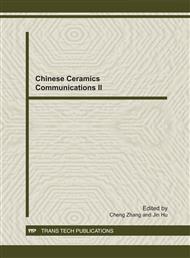p.116
p.121
p.125
p.129
p.133
p.138
p.142
p.146
p.150
Properties of SnO-B2O3-SiO2 Lead-Free Glass Powder
Abstract:
SnO-B2O3-SiO2 glass powders, in which the different contents of SnO and B2O3 were 35% ~ 70%wt and 26% ~ 61% wt respectively, were prepared through high-temperature melting, water quenching and Ball milling. XRD showed that the performance of forming glass was very good and the range of extension was very wide. The effect of the contents of SnO and B2O3 on Tg, acidoresistant and density of prepared glass was studied. IR showed that it generates the heavy metal oxide generated glass. The density of glass powder decrease with increase of B2O3 content, but increase with increasing SnO content. SnO-B2O3-SiO2 glass had excellent chemical stability. Differential thermal analysis (DTA) shown that, with increasing SnO content, glass transition temperature first lower and then decreased.
Info:
Periodical:
Pages:
133-137
Citation:
Online since:
November 2011
Authors:
Keywords:
Price:
Сopyright:
© 2012 Trans Tech Publications Ltd. All Rights Reserved
Share:
Citation:


